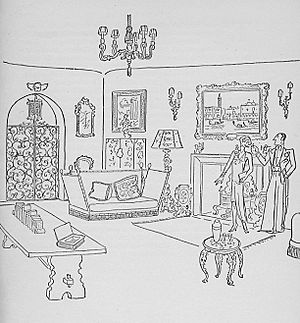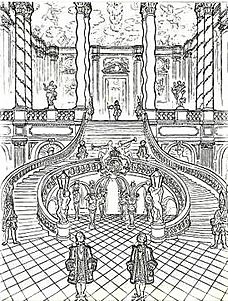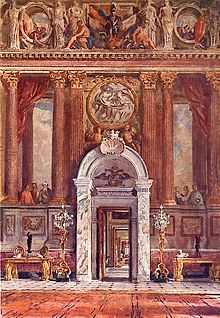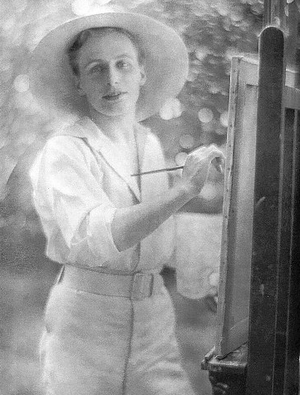Curzon Street Baroque facts for kids
Curzon Street Baroque was a special style of interior design popular in Britain between the two World Wars (around 1927 to 1939). It was a new take on the old Baroque style. This design was mostly found in the homes of rich and well-known British families. The name "Curzon Street Baroque" was created by a famous English cartoonist and writer named Osbert Lancaster. He chose this name because Curzon Street in Mayfair, London, was a very fashionable address where many wealthy people lived.
Unlike older Baroque styles that used light French furniture, Curzon Street Baroque often featured heavier, more solid furniture from Italy, Spain, and southern Germany. This made the style unique and new for its time.
Contents
The Start of Curzon Street Baroque
True Baroque architecture, both inside and out, uses lots of drama and surprises. It plays with light and shadow (called chiaroscuro) and features many fancy curves and shapes. However, the full Baroque style was never truly popular in Britain. It first appeared in Europe in the mid-1600s. In Britain, it had a short moment in the early 1700s, led by architects like Sir John Vanbrugh who designed Blenheim Palace and Castle Howard. But by the 1760s, a more serious style called Neoclassical architecture took over. Osbert Lancaster thought the British didn't like Baroque because they weren't keen on "cleverness," which Baroque design needed a lot of.
A New Look for an Old Style
Baroque interior design made a comeback in the 1920s. This was partly thanks to a book published in 1924 by Sacheverell Sitwell called Southern Baroque Art. This book talked about the very fancy Baroque style, which many people at the time thought was too much. Sitwell and his siblings, Edith Sitwell and Osbert Sitwell, were known as the Sitwells. They were a group of writers and artists in London who influenced many people.
The book made artists look at Baroque again. Painters like Rex Whistler started adding Baroque ideas to their art. Even society photographer Cecil Beaton used a "Baroque playfulness" in his work. Soon, top interior decorators picked up on this trend. They created a simpler, more modern version of Baroque for the 20th century. Osbert Lancaster then gave it the name Curzon Street Baroque.
Design Choices and Features
Curzon Street Baroque often mixed old and new furniture in the same room. It was seen as a move away from the very dark and cluttered Victorian style. People at the time didn't think much of Victorian architecture. For example, the writer PG Wodehouse joked that "few Victorians were to be trusted within reach of a trowel and a pile of bricks."
This new style avoided the straight lines of modern design and the dark wood of Victorian times. Instead, it used curves, often seen in "overwrought iron" and soft sofas. Rooms might have many twisted Baroque candlesticks and light-colored oak tables. Walls were often painted in soft pastel colors, like green. If people could afford it, they would add a special "feature panel" in a room. These were large paintings or murals, sometimes painted directly onto the walls, creating an illusion (called trompe-l'œil). For example, at Sandringham House, the dining room had valuable tapestries given by the King of Spain.
Outside, this revival style was less common. However, the architect Clough Williams-Ellis used a colorful Italian-inspired Baroque theme for his village design at Portmeirion.
What Made Up the Style

Osbert Lancaster said that key parts of Curzon Street Baroque included furniture painted by hand from Venice. Art in the style of Canaletto was also popular, though sometimes it was hard to tell if these paintings were real or not.
The style could also have a church-like feel. This was done with twisted Baroque candlesticks. Old leather-bound hymn books were sometimes hollowed out to hide cigarette boxes. Even old kneeling benches (called prie-dieux) were turned into cabinets to hide record players. Other art pieces included plaster saints painted with shiny colors.
Lancaster also noted that French furniture, which was a big part of earlier Baroque styles, was no longer considered fashionable. This furniture often had fancy gold details and curved legs (called cabriole legs). However, some designers, like Elsie de Wolfe, still used French-style furniture in their very feminine and showy designs.
The Feature Wall
A very important part of the style, though sometimes expensive, was the "feature wall." This was often a trompe-l'œil mural. These murals were meant to create a Baroque sense of surprise and illusion. The most famous painter of these murals was Rex Whistler. His notable works include the Tent Room at Port Lympne and a large Italian scene in the dining room at Plas Newydd from 1938. These murals and other paintings or tapestries were often set into wall panels instead of being in frames. This was a Baroque idea from the 1600s. It was also fine to mix old and new furniture in the same room. Sometimes, wrought iron gates were used instead of doors or window shutters, adding another Baroque touch.
Examples of the Style
Outside of London, wealthy people often used Baroque when fixing up their new country houses. For example, when the rich banker Vivian Smith, 1st Baron Bicester, bought Tusmore Park in 1929, he hired architects to remove the old, heavy wood and add a Baroque interior. This included a grand staircase hall with a double staircase, lots of wrought iron, arched openings, and a fancy chandelier hanging from a ceiling with a gilded starburst design. At Upton House, the architect added ornate fireplace decorations, columns, wall panels, and a curved indoor balcony, all in the fashionable, simplified Baroque style.
One of the best examples of Curzon Street Baroque is in the Italian Drawing Room at Eltham Palace. Even though most of the palace has an art deco design, Curzon Street Baroque was chosen for this main drawing room. The palace was greatly expanded between 1933 and 1936 for Stephen Courtauld and his wife Virginia. Their interior designer, Piero Malacrida de Saint-August, put in all the key features of the style. This included old wrought iron pieces from Spanish churches, heavy furniture, and gold light fixtures with parchment lampshades.
Who Was Involved with the Style
Many artists, designers, and writers were connected to Curzon Street Baroque:
- William Bruce Ellis Ranken (1881–1941)
- Elsie de Wolfe (1859–1950)
- Sybil Colefax (1874–1950)
- Osbert Sitwell (1892–1969)
- Sacheverell Sitwell (1897–1988)
- Osbert Lancaster (1908–1986)
- Rex Whistler (1905–1944)
- Piero Malacrida de Saint-August (1889-1983)
- Philip Tilden (1887–1956)
The End of the Style
The start of World War II in 1939 meant that people stopped spending money on fancy home makeovers. By the time Lancaster wrote about Curzon Street Baroque in 1939, he was already noticing other new styles. These included "Stockbroker Tudor" (heavy oak furniture) and "Modernistic" (which we now call 1930s Art deco).
Today, art deco is the style most people remember from the 1930s. It was seen as showing the energy of the 1920s and the hope of the tough 1930s. Curzon Street Baroque was a short-lived fashion for the very rich. It's mostly remembered today because it can still be seen in a few of their homes, like Coleton Fishacre, Eltham Palace, and Upton House.







